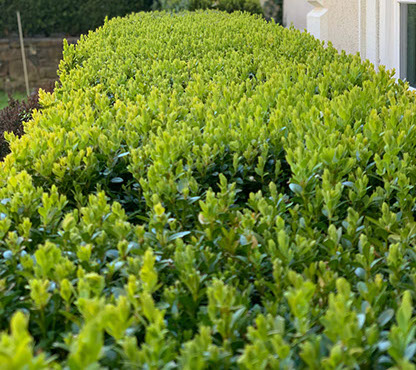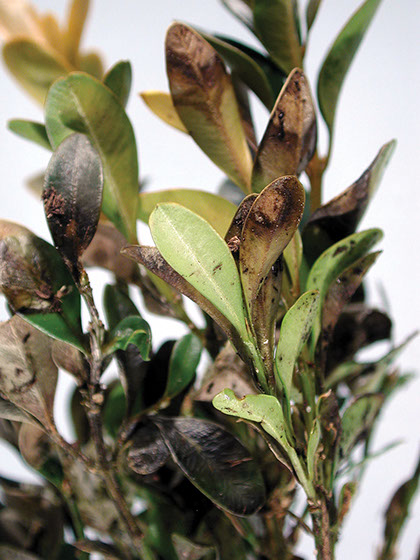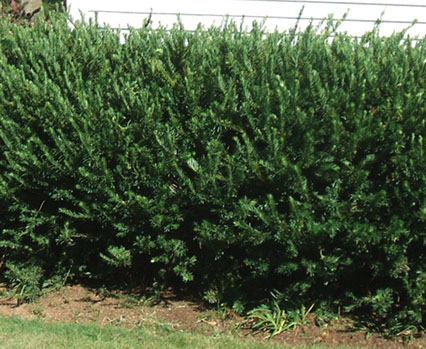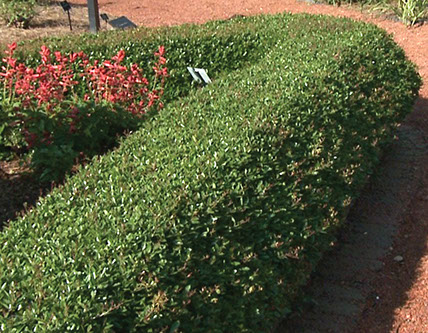
Summer 2020
Boxwood Blight Program
What you can do to protect your shrubs...
Boxwood (Buxus sp.), because of its vibrant green color, resistance to deer and woody evergreen growth, is an important but frequently over-utilized ornamental shrub on some landscapes. It is known to get infected by a number of plant diseases, including boxwood blight, boxwood dieback, macrophoma blight, phytophthora root rot and Volutella blight, as well as some common pests such as boxwood leafminer and psyllid. Boxwood blight, however, is by far the most serious of these issues and we are seeing a surge in our region.
What is boxwood blight?
Boxwood blight is a relatively new fungal disease that has only been around globally since 1994. It was first seen in the U.S. in 2011 in Connecticut and North Carolina. Since then, it has spread to several other states and Canada. Recently, this disease has become particularly widespread in Westchester County (NY), Fairfield County (CT) and Bergen County (NJ) landscapes. It is caused by Calonectria pseudonaviculata, a fungus that can be confused with similar-looking forms of dieback in boxwood. However, boxwood blight is much more devastating and can take out complete plantings. The spores can also be transmitted through pachysandra, which is also a host.
How do you identify boxwood blight?
You can identify boxwood blight by dark or light brown spots on the leaves and dieback on stems girdled by black cankers (see image). This is followed by severe leaf drop, either on a section of the shrub or the entire shrub.
Can boxwood blight be treated?
Whether or not your boxwood dies from the infection depends on plant vigor, weather, and factors such as irrigation type and shading. Even if not entirely killed, a shrub’s value as an ornamental is often destroyed by boxwood blight. The best course of action is to remove and destroy the infected shrubs, as well as all of the leaves and top 1/2 inch of soil and stump. Scientists are recommending that diseased plants and leaves be sanitarily removed and not used for composting, since the fungus can stay in dead leaves for up to 5 years. The removed shrubs, leaves and soil should be placed in a thick plastic bag and sent off for incineration.
Almstead's Boxwood Blight Program
Almstead has developed a new Boxwood Blight Program in coordination with Cornell University recommendations, Organic Approach (a premier supplier of organic products) and Winfield Solutions (one of the largest chemical distributors for agriculture, trees and ornamental shrubs). We are very excited about this new program. It seeks to improve plant health not only in growth but on a cellular level. Our goal is to strengthen the cellular walls of the membrane whereby defending against the spread of blight. In addition, three different fungicides are applied for preventive treatment throughout the growing season specifically in the spring and fall when the blight is active.
Protecting boxwood shrubs...
There are careful maintenance practices that can be followed to decrease the spread of boxwood blight. They include proper trimming and pruning techniques as well as being on an annual plant health care program. We recommend that pruning be done in the summer when the blight is more dormant. If you already have a valuable boxwood collection, do not introduce new boxwood to your property unless it is from a trusted source. And, only use clean and disinfected pruning tools when shearing or pruning your shrubs so as to not spread the blight from one area to another.
Plucking is the preferred method for pruning and thinning boxwood plants and an integral part of any preventative maintenance program. Selected stems from the plant are removed to facilitate air circulation, light penetration and inner growth of leaves. The shape of a plant can also be modified over time through regular plucking. Using a shear or hedge trimmer only removes the outer layer of leaves and promotes only outer growth while plucking facilitates the inner growth of leaves as well — and results in a more natural looking boxwood hedge.
If you have any additional questions about boxwood blight or other plant diseases, please call and schedule a visit with an Almstead arborist.

Beautiful boxwood hedges like this are at risk of devastation from boxwood blight.

Signs of boxwood blight include dark leaf spots that coalesce to form brown blotches. The undersides of infected leaves will show white sporulation. A key symptom that differentiates boxwood blight from other boxwood diseases are the narrow black streaks (cankers) that develop on green stems of the plant.

Close-up of black streaks cankers that develop on green stems of the plant as a result of boxwood blight.

Plucking is the preferred method for pruning boxwood shrubs.
Alternatives to Boxwood
Boxwood blight has become so widespread that many people are looking for alternative plants to use in their landscape. The following plants are similar in form, foliage, growth habit and landscape use but are not susceptible to boxwood blight. Please talk to your arborist for recommendations specific to your property.
- Alexandrian laurel (Danae racemosa)
- Carissa holly (Ilex cornuta ‘Carissa’)
- Distylium (Distylium x)
- Drooping leucothoe (Leucothoe axillaris)
- Dwarf arborvitae (Thuja sp.)
- Dwarf evergreen azaleas (Rhododendron sp.)
- Dwarf loropetalum (Loropetalum chinense) cultivars such as ‘Purple Pixie,’ ‘Purple Diamond’
- Dwarf oriental arborvitae (Platycladus orientalis) cultivars such as ‘Aurea Nana,’ ‘Westmont’
- Dwarf Yaupon Holly (Ilex vomitoria) cultivars such as: ‘Schillings Dwarf, ‘ ‘Nana, ‘ ‘Stokes Dwarf’
- Euphorbia ‘Blackbird’ (Euphorbia x)
- False holly (Osmanthus heterophyllus)
- Fragrant tea olive (Osmanthus fragrans)
- Germander (Teucrium fruticans)
- Hinoki cypress (Chamaecyparis obtusa) cultivars such as ‘Gracilis,’ ‘Nana Gracilis,’ ‘Rheingold,’ ‘Golden Globe’
- Holly fern (Cyrtomium falcatum)
- Inkberry Holly (Ilex glabra) cultivars such as ‘Compacta,’ ‘Shamrock’
- Japanese andromeda (Pieris japonica)
- Japanese falsecypress (Chamaecyparis pisifera) cultivars such as ‘Golden Mop,’ ‘Filifera Aurea’
- Japanese Holly (Ilex crenata) cultivars such as ‘Hoogendorn,’ ‘Helleri,’ ‘Convexa,’ ‘Hetzii’
- Japanese skimmia (Skimmia japonica)
- Knockout rose (Rosa x ‘Knockout’)
- Little-leaved viburnum (Viburnum obovatum)
- Rosemary (Rosemarinus officinalis)
- Saw palmetto (Serenoa sp.)
- Spreading yew (Cephalotaxus harringtonia)
- Skip Laurel (Prunus laurocerasus)
- Switchgrass (Panicum virgatum)
- Winter jasmine (Jasminum nudiflorum)
- Yellow rim (Serissa foetida)
- Yucca ‘Tricolor’ (Yucca sp.)

Spreading yew (Cephalotaxus harringtonia)

Dwarf Yaupon Holly (Ilex vomitoria)

Skip Laurel (Prunus laurocerasus)

LOCATIONS:
Lower Westchester County, NY and New York City
58 Beechwood Ave, New Rochelle, NY 10801
914-576-0193
Upper Westchester (North of I-287)
15 Broadway, Hawthorne, NY 10532
914-741-1510
Fairfield County, Connecticut
547 Hope Street, Stamford CT 06907
203-348-4111
Bergen & Passaic Counties, NJ
504 High Mountain Road, North Haledon, NJ 07508
973-636-6711
Contact us for a Free Consultation